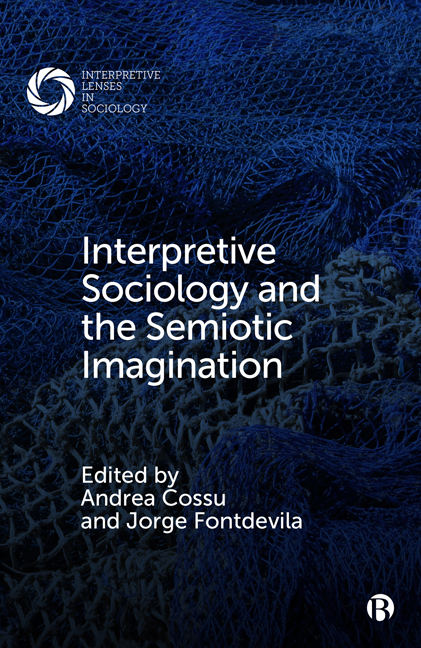Book contents
- Frontmatter
- Contents
- Series Editors’ Preface: Interpretive Lenses in Sociology—On the Multidimensional Foundations of Meaning in Social Life
- Notes on Contributors
- Introduction: Interpretive Sociology and the Semiotic Imagination
- 1 Marked and Unmarked: A Semiotic Distinction for Concept-driven Interpretive Sociology
- 2 Blumer, Weber, Peirce, and the Big Tent of Semiotic Sociology: Notes on Interactionism, Interpretivism, and Semiotics
- 3 Collective Agency: A Semiotic View
- 4 Theorizing Side-directed Behavior
- 5 Cultural Syntax and the Rules of Meaning-making: A New Paradigm for the Interpretation of Culture
- 6 Memory, Cultural Systems, and Anticipation
- 7 Stigma-embedded Semiotics: Indexical Dilemmas of HIV across Local and Migrant Networks
- 8 Supremacy or Symbiosis? The Effect of Gendered Ideologies of the Transhuman versus Posthuman on Wearable Technology and Biodesign
- Index
1 - Marked and Unmarked: A Semiotic Distinction for Concept-driven Interpretive Sociology
Published online by Cambridge University Press: 20 January 2024
- Frontmatter
- Contents
- Series Editors’ Preface: Interpretive Lenses in Sociology—On the Multidimensional Foundations of Meaning in Social Life
- Notes on Contributors
- Introduction: Interpretive Sociology and the Semiotic Imagination
- 1 Marked and Unmarked: A Semiotic Distinction for Concept-driven Interpretive Sociology
- 2 Blumer, Weber, Peirce, and the Big Tent of Semiotic Sociology: Notes on Interactionism, Interpretivism, and Semiotics
- 3 Collective Agency: A Semiotic View
- 4 Theorizing Side-directed Behavior
- 5 Cultural Syntax and the Rules of Meaning-making: A New Paradigm for the Interpretation of Culture
- 6 Memory, Cultural Systems, and Anticipation
- 7 Stigma-embedded Semiotics: Indexical Dilemmas of HIV across Local and Migrant Networks
- 8 Supremacy or Symbiosis? The Effect of Gendered Ideologies of the Transhuman versus Posthuman on Wearable Technology and Biodesign
- Index
Summary
A unifying theme in the chapters in this volume is that semiotics offers important analytic tools for understanding the creation and reproduction of contextual meaning in social life (see Introduction). Consistent with this theme, my research program has centered on the semiotic distinction between the socially marked and the socially unmarked. I have employed these sensitizing analytic concepts to examine a range of issues, including sexual identity (Brekhus, 1996), theoretical attention in sociology (Brekhus, 1998, 2000), cognition (Brekhus, 2015; Brekhus and Ignatow, 2019), risk (Brekhus, 2018), and identity (Brekhus, 2020). Broadly speaking, I focus on identity, difference, cognition, and representation, with a particular interest in the ways that intersecting dimensions of markedness and unmarkedness shape cultural perception, worldviews, cognition, and the reproduction of social inequalities.
The semiotic distinction between the marked and the unmarked was first introduced in the 1930s by linguists Trubetzkoy and Jakobson (see Jakobson, 1972; Trubetzkoy and Jakobson, 1975, p. 162). Linguist Linda Waugh (1982), in her article “Marked and Unmarked: A Choice between Unequals in Semiotic Structure,” developed the marked/unmarked distinction into a broader semiotic framework featuring semiotic pairs, such as blackness/whiteness and homosexuality/heterosexuality, across different semiotic systems (see also Zerubavel, 2018, p. 2). Following the lead of Waugh, who argued that the same logic of the actively accented (marked) and the passively unacknowledged (unmarked) that applied to linguistic contrasts also applies to social contrasts, I have helped to import these concepts into the social sciences. In my own work, inspired by Waugh's analysis, I first applied a semiotic markedness/unmarkedness analysis to sexual identity construction in the US (Brekhus, 1996), wherein I noted that some sexual behaviors and identities are marked as “deviant” and given special labels, while others remain unmarked, unaccented, and even unlabeled. Thus, for instance, “the social marking process is metaphorically illustrated in Nathaniel Hawthorne's [novel] [The] Scarlet Letter where Hester Prynne's community literally marks her with a Scarlet Letter ‘A’ [that] symbolizes her identity as an ‘adulteress’ and sets her apart from the unmarked category of ‘marital loyalists,’ “ but Prynne's neighbors are not similarly required to mark their own identity as “marital loyalists” with an “ML” (Brekhus, 1996, p. 500).
- Type
- Chapter
- Information
- Interpretive Sociology and the Semiotic Imagination , pp. 31 - 51Publisher: Bristol University PressPrint publication year: 2023

